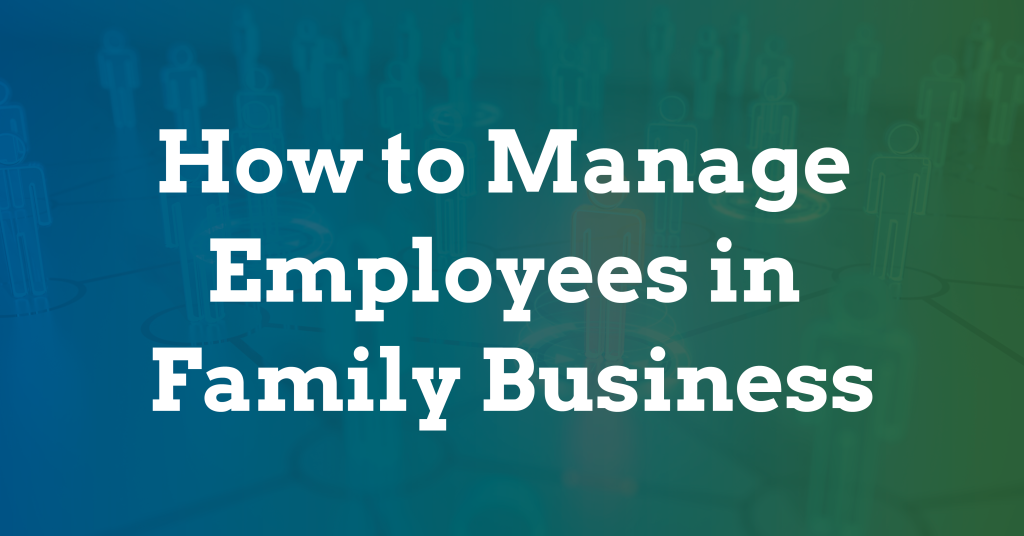Family-owned businesses account for 59% of the United States’ private sector workforce, employing more than 83 million people, according to familybusiness.org.
Suffice it to say, family firms make up a significant portion of the economy, with businesses large and small sharing common challenges with managing the employees that drive business growth.
While family businesses, overall, are better at retaining these employees compared to non-family firms, according to Harvard Business Review, they also have unique dynamics that can make employee management challenging. In fact, adding family dynamics into the mix often makes decisions more complicated for family leadership.
There is much at stake with every hiring, promotional, or even disciplinary action taken by the leading generation in a family business. These generally fall into three categories:
- Interfamily dynamics – how business decisions impact personal relationships between family members (e.g. leading-gen and next-gen)
- Intrafamily dynamics – how family business decisions impact the professional development of family members
- Non-employee dynamics – how family business decisions impact the personal or professional relationships between non-family employees and their employers, or other family members within the business
So how can an employer keep both family and non-family members of a workforce engaged, productive, and amicable? We dive in deeper below.
Why are family businesses better at retaining employees anyway?
Family-owned businesses have an advantage in that, with effective communication, they can develop more authentic feelings of family and togetherness among staff. If employees better understand the culture and values of the family in charge, they may also identify themselves within that culture and accept the family’s goals as their own.
When family values are an intentional part of your communication strategy, (more on that later), the sense of togetherness may reduce the allure of potentially better paying positions elsewhere, as leaving the organization would be akin to losing a part of oneself. Family firm managers should recognize that leaving a family is more difficult than leaving a job.
Non-family employees within a family business may also have greater input on their day-to-day work. The ability to speak and know your thoughts will be heard and taken seriously by family members who may influence decisions within the business is an empowering retention tool when managed effectively.
The effect also works in reverse.
Non-family employees become “adopted” members of the family, and so are treated better, including through better compensation and benefits. According to Family Enterprise USA, “America’s family enterprises tend to hold on to their employees longer and treat them better than non-private sector workplaces.”
In sum, the bonds that hold a family business together are difficult to break. When all employees understand how their role impacts the greater mission of the business, they are less likely to abandon their work family, even if compensation may be more attractive elsewhere.
However, building and maintaining that culture is not a simple task. Business leaders must be proactive to enjoy the advantages of a family business culture.
Employee management in a family business
The principles of employee management are the same in family business as they are in private business and other organizational structures.
Plan. Communicate. Repeat.
That includes development plans and channels of communication for every employee, family or non-family. It also requires consistency and accountability at all levels of the business.
The biggest threat to morale is the perception that one individual is receiving preferential treatment over another. That’s why considering interfamily, intrafamily, and non-family dynamics with every decision is critical.
Steps for effective staff management
Step 1: Establish a clear governance and communication structure
Answering the 5 W’s and H regarding how information is relayed at every level of business provides an essential foundation for success.
- Who should communicate information?
- What information should be communicated?
- When should information be communicated?
- Where should information be communicated?
- Why should information be communicated?
- How is information communicated?
These questions are not only for the leading generation to consider. They should guide every interaction that happens within the family business to avoid miscommunication that leads to resentment.
Consider how damaging a message can be if just one of these elements is missing. You may have a perfectly crafted message, delivered through appropriate channels at the right time, but if that message is delivered by the wrong person, rank and file employees may be confused, distrusting, and ultimately not accept the intended message.
Or, the right person communicates in a way that perfectly explains the company’s rationale for making a decision. However, if that individual can’t strike the right tone (the “How?), staff may receive mixed signals. For instance, exciting news that’s delivered in a dull, uninteresting meeting. Or bad news that’s a surprise to staff, delivered in an email, versus using more transparent and personal communication methods.
Think deeply about who communicates information within your business, then ensure those individuals, including all family members, have a deep understanding of your “5 W’s and H.”
Step 2: Create constructive feedback loops
Once again, communication is key (notice a theme here?). When family values are not made to be a part of your communication strategy, research shows non-family employees may not be so eager to stick around.
Family Business Review (via FamilyBusiness.org) found that in such cases, nonfamily employees who don’t feel connected to the family’s values instead feel like outsiders whose opinions don’t matter. “To prevent such problems, family businesses should create organizational practices that increase employee participation and make nonfamily employees feel valued and included.”
Some examples may include:
- Introduce “suggestion boxes,” anonymous or not, for feedback sent directly to the CEO
- Hold regular one-on-one meetings with managers or C-Suite leadership
- Involve representatives from all areas of business in important decision-making processes
- Create opportunities for socialization with the family outside of work
The potential culture benefits of family business are only realized if positive relationships are built between family and non-family employees. Ignoring this step may lead to an “us against them” mentality for both sides. Too often, this mentality is the source of conflict that undermines family business performance.
Step 3: Apply accountability equally
Regular evaluations are a necessary step to identify areas of improvement. But what happens when it’s a family member who is underperforming?
The dynamics in these cases are tricky.
- Interfamily dynamics – How can feedback be delivered in a way that doesn’t create tension around the holidays
- Intrafamily dynamics – How can constructive criticism be communicated so that the family member remains engaged in the family business and/or their own professional development?
- Non-family dynamics – How do others within the business perceive the family member’s performance, and what will their reaction be to corrective action?
Without a doubt, one of the key incentives to starting or maintaining a successful family business is to ensure employment opportunities for future generations. This fact alone suggests a form of preferential treatment for family employees. It may also create a built-in sense of entitlement for family members entering the business.
Without clear expectations in the form of individual development plans, as mentioned above, family members may feel immune to the regular consequences of lacking or disruptive behavior.
The implications for non-family employees are obvious. Double standards for family and non-family employees are a quick way to push non-family employees out the door.
We also see that unclear expectations damage interfamily relationships, even when intentions are to help and protect family members within the business.
For example, leading generations, especially those who founded the business, cannot relate to the workstyles of younger generations. Or, they struggle to understand why the next-gen does not share the same passion or values for the family business. In many cases, the leading generation may demand more from family employees when compared to non-family.
There are a few actions every family business owner should take to ensure employees are treated fairly.
Employee Management Best Practices
Set clear expectations
At the start of employment, have an open discussion with all employees about expectations. As Harvard Business Review writes, “probe and listen deeply to understand how they see themselves, and what they believe they can contribute. Respond with a kind, unambiguous description of the expectations you and the rest of the leadership have for them, and restate those expectations in a follow-up email thanking them for the conversation. After you’ve gone on record, it’s a little easier to refer to those expectations in subsequent conversations about performance.”
Identify who will deliver feedback
Refer back to step 1, and consider if evaluations should be performed by family, or non-family managers. Delegating feedback to a neutral third-party may shield family members from the relationship implications of sharing negative feedback. However, it is critical that all managers understand the expectations set at the beginning of employment, so the leading generation is on the same page and can support those performing evaluations.
Likewise, it may be necessary that certain feedback is shared by family members in charge for those points to be taken seriously.
Stick to the plan, then start again
As part of expectation-setting, outline the specific actions that will result from poor performance. These consequences may be financial in nature, such as denial of a raise or promotion. They may also be career motivated, such as reduced workload or reassignment to another position within the company. Be sure to also include incentives for positive performance. Holding family and non-family employees to the career path agreed upon from the outset instills a feeling of purpose while reducing the potential for disputes.
Once you take action, start the process over again. Humans are not static beings. Interests and abilities change over time. Through open and transparent communication, you can better anticipate the needs of your workforce and adapt expectations as needed.
For example, a family member on a path to a leadership role may later discover another role within the business that better suits their skillset. Others may feel a pull to gain experience and perspective in a completely different industry and leave the family business, permanently or temporarily.
Respecting those wishes and using your time with an employee to help them grow and develop in their own careers can only help your company’s internal and external reputation.
Ultimately, the time spent listening to the unique needs of your employees, communicating your goals and values, and holding all individuals to the same standard is the foundation by which your company can maintain relationships and avoid costly employee conflicts.
If you need help determining an approach for managing employees in your family business, consider becoming a Conway Center for Family Business member, or reach out directly to info@familybusinesscenter.com.

